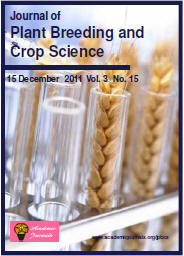Department of Forestry and Fisheries, Usmanu Danfodiyo University (UDU), Sokoto, Sokoto State, Nigeria.
Accepted 1 November, 2011
This study was conducted at Usmanu Danfodiyo University, Sokoto, Nigeria to determine the nutrient composition of four tree seeds. The tree species served as treatments and were replicated four times in a completely randomized design. The seeds of the four tree species randomly selected were analysed for the nutrient and mineral elements. The results showed that; highest moisture and fat contents of 13.75 and 17.125% were recorded in Parkia biglobosa seed and the lowest of 6.5 and 2.125% in Acacia nilotica seed. The highest ash content of 4.5% was recorded in A. nilotica seed and the lowest (2.375%) in Balanites aegyptiaca seed. The highest crude fiber content was recorded in P. biglobosa seed (1.375%) and the lowest (0.75%) in Ziziphus spina-christi seed. 17.66% was the highest crude protein in P. biglobosa seed and the lowest (0.73%) in B. aegyptiaca seed. High content of nitrogen free extract (NFE) was recorded in A. nilotica seed with 91.154% and the lowest in P. biglobosa seed with 60.458%. High sodium content was recorded in A. nilotica seed with 87.25 ppm and the lowest in Z. spina christi seed with 51.8 ppm. The highest magnesium, potassium and phosphorous contents of 2.175, 712.5 and 6.5 ppm were recorded in p. biglobosa seed. The highest calcium content (2.075 ppm) was found in A. nilotica seed. Further research with different species of tree seeds (of good quality or from plus trees) should be carried out for enhancing long term values of the trees.
Key words: Forest trees, artificial regeneration, nutrient composition, proximate analysis.
Key words: Forest trees, artificial regeneration, nutrient composition, proximate analysis.
Sources: Complete Journal












0 komentar:
Post a Comment